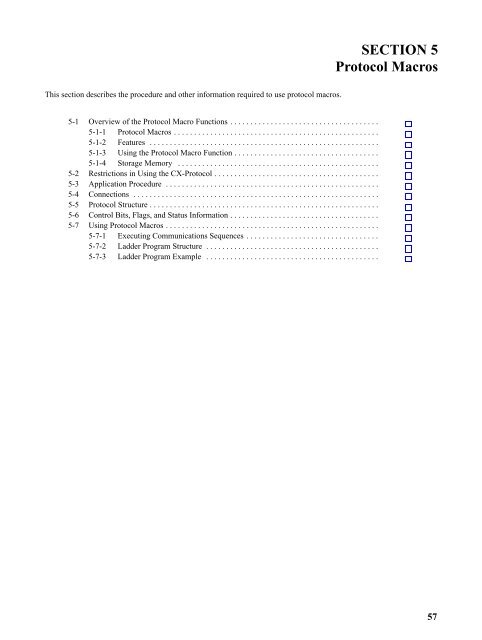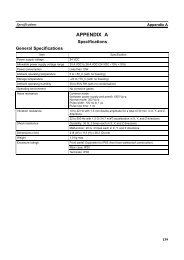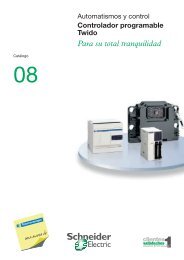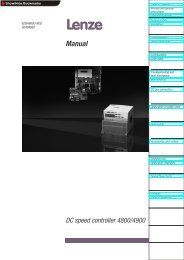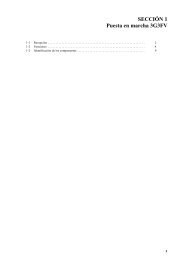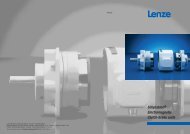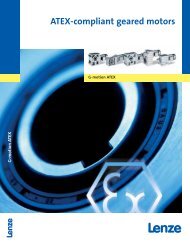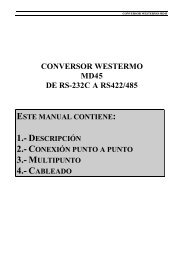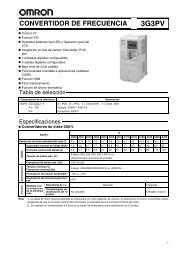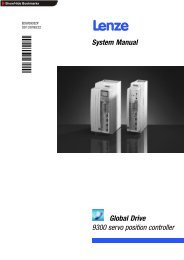SECTION 5 Protocol Macros - Valtek
SECTION 5 Protocol Macros - Valtek
SECTION 5 Protocol Macros - Valtek
Create successful ePaper yourself
Turn your PDF publications into a flip-book with our unique Google optimized e-Paper software.
<strong>SECTION</strong> 5<strong>Protocol</strong> <strong>Macros</strong>This section describes the procedure and other information required to use protocol macros.5-1 Overview of the <strong>Protocol</strong> Macro Functions . . . . . . . . . . . . . . . . . . . . . . . . . . . . . . . . . . . . .5-1-1 <strong>Protocol</strong> <strong>Macros</strong> . . . . . . . . . . . . . . . . . . . . . . . . . . . . . . . . . . . . . . . . . . . . . . . . . . .5-1-2 Features . . . . . . . . . . . . . . . . . . . . . . . . . . . . . . . . . . . . . . . . . . . . . . . . . . . . . . . . .5-1-3 Using the <strong>Protocol</strong> Macro Function . . . . . . . . . . . . . . . . . . . . . . . . . . . . . . . . . . . .5-1-4 Storage Memory . . . . . . . . . . . . . . . . . . . . . . . . . . . . . . . . . . . . . . . . . . . . . . . . . .5-2 Restrictions in Using the CX-<strong>Protocol</strong> . . . . . . . . . . . . . . . . . . . . . . . . . . . . . . . . . . . . . . . . .5-3 Application Procedure . . . . . . . . . . . . . . . . . . . . . . . . . . . . . . . . . . . . . . . . . . . . . . . . . . . . .5-4 Connections . . . . . . . . . . . . . . . . . . . . . . . . . . . . . . . . . . . . . . . . . . . . . . . . . . . . . . . . . . . . .5-5 <strong>Protocol</strong> Structure . . . . . . . . . . . . . . . . . . . . . . . . . . . . . . . . . . . . . . . . . . . . . . . . . . . . . . . . .5-6 Control Bits, Flags, and Status Information . . . . . . . . . . . . . . . . . . . . . . . . . . . . . . . . . . . . .5-7 Using <strong>Protocol</strong> <strong>Macros</strong> . . . . . . . . . . . . . . . . . . . . . . . . . . . . . . . . . . . . . . . . . . . . . . . . . . . . .5-7-1 Executing Communications Sequences . . . . . . . . . . . . . . . . . . . . . . . . . . . . . . . . .5-7-2 Ladder Program Structure . . . . . . . . . . . . . . . . . . . . . . . . . . . . . . . . . . . . . . . . . . .5-7-3 Ladder Program Example . . . . . . . . . . . . . . . . . . . . . . . . . . . . . . . . . . . . . . . . . . .57
Overview of the <strong>Protocol</strong> Macro Functions5-1 Overview of the <strong>Protocol</strong> Macro FunctionsSection5-15-1-1 <strong>Protocol</strong> <strong>Macros</strong>The protocol macro function is used to control devices by using the PMCR(––)instruction in the ladder program to execute the data communications sequences(protocols) with the various communications devices, such as generalpurposedevices, connected to the RS-232C or RS-422A/485 port.Standard system protocols are provided in the Serial Communications Board forcontrolling OMRON devices (such as Digital Controllers and Temperature Controllers).Using the <strong>Protocol</strong> Support Tool called the CX-<strong>Protocol</strong>, the protocol macrofunction can be used to create new protocols for commercially available measuringinstruments and devices, and to create protocols by modifying one of thestandard system protocols. The standard system protocols are also providedwith the CX-<strong>Protocol</strong>.For details on the use of the CX-<strong>Protocol</strong> and the protocol macro function, referto the CX-<strong>Protocol</strong> Operation Manual (W344).5-1-2 FeaturesWide Range ofCommunications<strong>Protocol</strong>sCustomized Send andReceive FramesCommunications-relatedFunctionsSend/Receive MonitoringRetry ProcessingPC Read/Write Variablesin Send Frames andReceive FramesSwitch 1:NCommunications or theData Write DestinationsUsing Repeat ProcessingPC Interrupts DuringData ReceptionNext Process SwitchingAccording to ReceiveMessagesThe main features of the protocol macro functions are described below. For details,refer to the CX-<strong>Protocol</strong> Operation Manual (W344).Communications are possible with virtually any general-purpose external device,provided it has an RS-232C or RS-422A/485 port, supports half-duplexcommunications, and supports start-stop synchronization.Send frames (command + data and other send frames) and receive frames (responseand other frames) can be created and registered according to the communicationsframe specifications of the external device.Error check code calculations, frame length calculations during sending, andASCII⇔Hexadecimal conversion of numeric data are supported.Receive wait monitoring, receive completion monitoring, and send completionmonitoring are supported. If monitoring times are exceeded, either send/receiveprocessing can be terminated or retry processing can be performed.Send/receive retry processing can be automatically executed when an error occurs,simply by setting the number of retries.Variables for reading PC memory can be included in the send frames. These canbe used as destination addresses or data when reading PC data. Variables forwriting to PC memory can be also included in the actual receive frames. Thesecan be used to write the contents of destination addresses or data to the PC duringreception.Repeat processing (repeat counters) for send/receive processing can be specifiedin communications sequences. This enables the same data to be sent byswitching destination addresses during communications 1:N (N = 32 max. dueto restrictions in the physical layer) or by switching the PC memory write destinationaddresses during data reception.An interrupt can be created in the PC’s CPU Unit during data reception, and aninterrupt program can be executed in the CPU Unit.The contents of up to 15 expected receive messages can be compared with themessage actually received to determine the next process.58
Overview of the <strong>Protocol</strong> Macro FunctionsSection5-1<strong>Protocol</strong> Macro Function SpecificationsItemNumber of protocols (20 max.)Number of sequences (1,000 max.)DescriptionCan be created and registered with the <strong>Protocol</strong> Support Tool(CX-<strong>Protocol</strong>).Per protocolNumber of 60 max.sequencesNumber of 300 max.messagesNumber of 100 max.receptionmatrixes<strong>Protocol</strong> data memoryFlash memory in the Serial Communications Board (Retained evenwhen the power supply to the PC is turned OFF.)Sequence execution conditionUsing the CPU Unit’s PMCR(––) instruction (specifying the sequencenumber)Communications modeHalf-duplexSynchronous modeStart-stop synchronization (asynchronous mode)Baud rate (see note)RS-232C port and RS-422A/485 ports:1,200/2,400/4,800/9,600/19,200 bpsDefault setting: 9,600 bpsCommunications distance (see note) RS-232C port: 15 m max.RS-442A/485 port: 500 m max. (The total combined cable length is500 m max. T-branch lines must be a maximum of 10 m long.)Connection configurationRS-232C port: 1:1 (1:N (N = 32 Units max.) is possible using aConverting Link Adapter.)RS-422A/485 port: 1:N (N = 32 Units max.)Number of connected Units 32 Units max. (unit numbers 0 to 31; unit number 0 is set for 1:1connection)Maximum number ofdata exchange wordsOperand setting 127 words Including the word that specifies the number ofwords (1 word)between PC andprotocol macroLink word setting 128 words O1, O2, I1, and I2: 128 words totalfunction Direct setting 128 words Maximum number of words per data attribute59
Overview of the <strong>Protocol</strong> Macro FunctionsSection5-1ItemSequence contents Number of steps(step commonper sequenceparameters)TransmissioncontrolparametersResponsenotificationmethod (operand)Monitoring timeduringsend/receiveprocessingLink word setting16 max.DescriptionX-on/X-off flow, RTS/CTS flow, delimiter control, or contention control,and modem control can be selected.Scan notification or interrupt notification (i.e., writing the receive data inthe I/O memory area specified in the 3rd operand of the PMCR(––)instruction) can be selected.Scan notification:Writes the receive data to I/O memory during CPU Unit scanning.Interrupt notification:Writes the receive data to I/O memory as soon as it is received, and atthe same time specifies the execution of the interrupt program for theCPU Unit.Scan method Yes(fixed)InterruptYesnotificationInterruptYesnotification forreception casenumberReceive wait, receive completion, or send completion can bemonitored.Setting range: 0.01 to 0.99 s, 0.1 to 9.9 s, 1 to 99 s, or 1 to 99 minArea in which data is exchanged between the CPU Unit and the SerialCommunications Board during Serial Communications Boardrefreshing. Two areas are possible for each device: An area for storingreceive data and an area for storing send data.60
Overview of the <strong>Protocol</strong> Macro FunctionsSection5-1ItemDescriptionStep contents Commands Send only (SEND), receive only (RECEIVE), or send and receive(SEND&RECEIVE)Repeat counter 1 to 255 timesRetry count 0 to 9(Only when the command is SEND&RECEIVE)Send wait time 0.01 to 0.99 s, 0.1 to 9.9 s, 1 to 99 s, or 1 to 99 min(Only when the command is SEND or SEND&RECEIVE)With or withoutresponse write(operand)Next processingError processingSend messageReceive messageReception matrixWhen receive processing is completed (when the receive data isstored in the area specified in the 3rd operand of the PMCR(––)instruction), whether or not to store the received messages can beselected.When a step has ended normally, End (sequence completed), Next(proceed to the next step No.), Goto (go to the specified step No.), orAbort (interrupt the step and terminate that sequence) can be selected.When a step has ended abnormally, End, Next, Goto, or Abort can beselected.Data sent to thespecified addresswhen the commandis SEND orSEND&RECEIVE.Data sent from thespecified addresswhen the commandis RECEIVE orSEND&RECEIVE.When thecommand isRECEIVE orSEND&RECEIVE,sets the expectedreceive messages(15 max.), andswitches to thenext processingaccording to themessage received.Consists of a header (*1), address (*2), length,data (*2), error check code (*3), and terminator(*1).For an explanation of *1, *2, and *3, see thefollowing pages.Specifies the receive messages and the nextprocessing for each of cases No. 00 to No. 15.Of the maximum 16 cases, one case must be setas “Other” in the receive messages (in addition tothe set receive messages).Note The baud rate and the communications distance sometimes depend on the remotedevice.61
Overview of the <strong>Protocol</strong> Macro FunctionsSection5-1ItemDescriptionMessage contentsConstantConstantVariablesASCII data, hexadecimal data, or control codeASCII data, hexadecimal data, or control code (with an address, no controlcode is possible)No conversion, conversion to ASCII data, or conversion to hexadecimal data(the read/write direction can be specified)*1:Header andterminatordata attributes*2:Data attrib-utes of addressesanddata in send/receive messagesDesignationmethod(X, Y)X: Effective address (where read from, or where written to)Y: Data size (1 to 256)XYNoteWorddesignationThe data size is the number of bytes on the transmissionpath.Word read (I/Omemory tosend data)Word write (receivedata toI/O memory)Specify usingthe 2nd operandof thePMCR(––)instruction.Specify usinga link word.I/O memory directdesignationSpecify usingthe 3rd operandof thePMCR(––)instruction.Specify usinga link word.I/O memory directdesignationSet leadingaddress + n(The linear expressionaN +b, including re-peat counterN, is also pos-sible for n.)Wild card * Any data or address can be received(only in receive messages)RepeatcounterNLinear expressionaN + b a: 0 to 255; b: 1 to 255includingrepeat counterN: Repeat counter valueWild card * Can be received regardless ofthe length (only in receive messages)Word designationWord read (I/Omemory tosend data)Specify usingthe 2nd operandof thePMCR(––)instruction.Specify usinga link word.I/O memory directdesignationSet leadingaddress + n(The linear expressionaN +b, including re-peat counterN, is also pos-sible for n.)62
Overview of the <strong>Protocol</strong> Macro FunctionsSection5-1Message contents(contin-ued)Trace functionItem*3:Error check codesMaximum length of 256 bytes.send/receive messagesMaximum number of 96 attributes (see note 1)data attributes registeredin one messageMaximum number of 30 attributes (see note 2)write data attributesregistered in one messageDescriptionLRC, LRC2, CRC-CCITT, CRC-16, SUM, SUM1, and SUM2 can be calculated.A total of up to 1,700 bytes (characters) of time-series data can be traced insend and receive messages.Changes to the step No. and control signals such as RTS and CTS can alsobe traced.Note1. The CX-<strong>Protocol</strong> can be used to register up to 96 attributes per message.2. A macro syntax error will occur when the protocol macro is executed if morethan 31 write attributes are registered in one message.5-1-3 Using the <strong>Protocol</strong> Macro FunctionThe following three methods are available for using the protocol macro function.Using the StandardSystem <strong>Protocol</strong>sWhen connecting OMRON devices, data is sent and received between theCQM1H-series CPU Unit and these devices by specifying the sequence numberof the standard system protocol provided in the Serial Communications Boardand CX-<strong>Protocol</strong>, and executing the sequence using the PROTOCOL MACROinstruction (PMCR(––)). The CX-<strong>Protocol</strong> is not required to use the standardsystem protocols.CPU UnitSequencenumberSequence No.specificationSerial Communications BoardStandard system protocolSequence No. 001Step 0Step 1MessagesRS-232C orRS-422A/485*Send/receive messages arestored in the area one or morewords after the send dataaddress or the receive dataaddress specified in thePMCR(––) instruction.OMRON devicesI/O memoryI/O refreshingShared memoryNote The devices for which standard system protocols are provided are listed below.For details, refer to 5-7 Using <strong>Protocol</strong> <strong>Macros</strong>.Digital Controllers (E5K, ES100), Temperature Controllers (E5ZE,E5J), Intelligent Signal Processors (K3T), Bar Code Readers(V500/V520), Laser Micrometers (3Z4L), Visual Inspection Units(F200/F300/F350), ID Controllers (V600/V620), Hayes Modem AT Command,and devices supporting the CompoWay/F protocol.63
Overview of the <strong>Protocol</strong> Macro FunctionsSection5-1Modifying StandardSystem <strong>Protocol</strong>sIf there is no standard system protocol for the required OMRON product or youwish to modify part of the protocol, you can use the CX-<strong>Protocol</strong> to modify a standardsystem protocol, transfer this as a separate communications sequence tothe Serial Communications Board, and execute the PMCR(––) instruction.Modifying and transferringstandard system protocolsCPU UnitSerial Communications BoardSequencenumberSequence No.specificationModified standardsystem protocolStep 0Step 1Command execution (SEND, RECEIVE,SEND&RECEIVE)MessagesStep 2RS-232C or RS-422A/485General-purpose external deviceI/O memoryShared memoryI/O refreshingCreating a New <strong>Protocol</strong>When connecting a general-purpose external device that has an RS-232C orRS-422A/485 port, use the CX-<strong>Protocol</strong> to create a new protocol containing thecommunications specifications for the general-purpose external device, transferthese specifications to the Serial Communications Board, and execute thePMCR(––) instruction.Creating and transferring a new protocolSerial Communications BoardCPU UnitNewly created protocolCommand execution (SEND, RECEIVE,SEND&RECEIVE)SequencenumberSequence No.specificationStep 0Step 1MessagesStep 2RS-232C or RS-422A/485General-purpose external deviceI/O memoryShared memoryI/O refreshing64
Restrictions in Using the CX-<strong>Protocol</strong>Section5-25-1-4 Storage MemoryIn this manual, the protocol structure is explained in simple terms, and examplesare given of the use of the PMCR(––) instruction when controlling OMRON devicesusing standard system protocols. For details on the protocols, the methodof modifying the standard system protocols, and the method of creating new sequences,refer to the CX-<strong>Protocol</strong> Operation Manual (W344).The protocol macros are stored in flash memory in the Serial CommunicationsBoard and will be saved even if power to the CQM1H is turned OFF. The PC Setupsettings for the Serial Communications Board are stored in memory in theCPU Unit with a battery backup.5-2 Restrictions in Using the CX-<strong>Protocol</strong>There are some restrictions in using the CX-<strong>Protocol</strong> to manipulate protocols orperform other operations for the CQM1H-series Serial Communications Board.These restrictions are described below.• Pin 8 on the DIP switch on the front of the CQM1H-series CPU Unit must beturned ON to use the CX-<strong>Protocol</strong>. While pin 8 is ON, you will not be able to useany of the CPU Unit or Board ports for the CX-Programmer, SYSMAC-CPT, orSYSMAC Support Software.• The model of PC must be set to the C200HG and the model of CPU Unit mustbe set to the CPU43.• Refer to the following table for details and for other restrictions. Unless specified,the functionality of the CX-<strong>Protocol</strong> will be the same as for the C200HX/HG/HE.Item Restriction ProcedureCQM1H DIPswitch settingsPC model setting(to create newprotocols)Transferringprotocols to thecomputerTurn ON pin 8 on the DIP switch on the front of theCQM1H-series CPU Unit before attempting to use theCX-<strong>Protocol</strong>. You will not be able to use theCX-<strong>Protocol</strong> while pin 8 is OFF.While pin 8 is ON, you will not be able to use any of theCPU Unit or Board ports for the CX-Programmer,SYSMAC-CPT, or SYSMAC Support Software. Alwaysturn OFF pin 8 after you are finished using theCX-<strong>Protocol</strong>.Set the model of PC to the C200HG and the model ofCPU Unit to the CPU43-E.You will not be able to upload the data for the standardsystem protocols from the Board to the computer. If anattempt is made, the transfer will be canceled and thefollowing message will appear. (The standard systemprotocol data in the Board will not be affected.)Decompiler has detected an error. No protocol dataor invalid protocol list on upload. It is likely that theprevious download was interrupted or the PMSUmemory has been cleared/damaged. Try todownload a valid protocol and retry upload.You will be able to download protocol data from thecomputer to the Board (including data for the standardsystem protocols) and will then be able to upload thedata. To modify the standard system protocols for yourapplications, modify the data provided with theCX-<strong>Protocol</strong> and then download the data to the Board.Turn ON pin 8 before using theCX-<strong>Protocol</strong>.Turn OFF pin 8 after you are finishedusing the CX-<strong>Protocol</strong>.1. Select New from the File Menu.2. Select C200HG from the Change PLCDialog Box.3. Select CPU43-E from the SettingsDialog Box.---65
Application ProcedureSection5-3ItemCommunicationsport settings onthe BoardI/O memoryoperations: PLCMemory WindowError logI/O tablesRestrictionUse the same communications port settings for theBoard as those used for the C200HX/HG/HE. Thecommunications port names will be as follows:Communications Port A will be port 1 on the Board.Communications Port B will be port 2 on the Board.Use I/O memory addresses only within the rangessupported by the CQM1H. Do not attempt to editaddresses IR 256 and higher in the IR Area (displayedwithout the prefix) even though these addresses will bedisplayed.The following restrictions apply when transferring I/Omemory.When transferring from the computer to the PC, do notselect All. Use Selection or Range and specify a rangethat lies between IR 000 and IR 255.When transferring from the PC to the computer, do notselect All. Use Visible area only or Selection andspecify a range that lies between IR 000 and IR 255.The error log cannot be used. If it is displayed, thecontents will not agree with the error log in the CQM1H.The I/O tables are not necessary for the CQM1H andwill be disabled. If an attempt is made to create I/Otables, the following message will be displayed and theI/O tables will not be created.! The PLC does not contain an IO Table.Procedure1. Double-click the PC icon while online.2. Double-click the Communications PortA or Communications Port B Icon inthe Project Window.3. Make the settings in theCommunications Port Settings Dialog.1. Click the PC icon and select Memoryfrom the pop-up menu. The PLCMemory Window will be displayed.2. Select the I/O memory areas andaddress to be displayed or edited in theData Area Workspace.1. Double-click the memory area in theData Area Workspace. The PLC DataTable will be displayed.2. Specify the range of addresses to betransferred if necessary.3. Select Transfer to PLC via Online orTransfer from PLC via Online fromthe Online Menu.------5-3 Application Procedure1, 2, 3... 1. Turn OFF the power to the PC.2. Install the Board.3. Connect the system.Connect the external devices using RS-232C or RS-422 cable. The settingsof the TERM and WIRE switches on the front panel of the Board will need tobe changed if the RS-422A/485 port on the Serial Communications Board isused.Serial Communications BoardTerminating resistance ONExternal deviceExternal deviceExternal deviceTerminating resistance ONExternal deviceConnect a Programming Console, the CX-Programmer, or the CX-<strong>Protocol</strong>to the CPU Unit as required.4. Turn ON power to the PC.5. Set the PC Setup settings for the Serial Communications Board.Use the Programming Console, CX-Programmer, or CX-<strong>Protocol</strong> to set thesettings in DM 6550 to DM 6559.66
Application ProcedureSection5-3Note The PC Setup settings for the Serial Communications Board are readconstantly during PC operation. It is not necessary to restart the PCafter changing these settings.The default settings are shown in the following table. These are the standardsettings for protocol macros.Port 1 Port 2 Bit(s) Setting FunctionDM 6555 DM 6550 00 to 03 0 Hex Standard port settings (1 start bit,7-bit data, even parity, 2 stop bits,9,600 bps)04 to 07 --- Not used.08 to 11 --- Not used.12 to 15 6 Hex Communications mode:<strong>Protocol</strong> macroDM 6556 DM 6551 00 to 07 --- Baud rate setting disabled.08 to 15 --- Frame format setting disabled.DM 6557 DM 6552 00 to 15 --- Not used.DM 6558 DM 6553 00 to 15 --- Not used.DM 6559 DM 6554 00 to 15 --- Not used.6. Run the system as described below in Using Standard System <strong>Protocol</strong>s orin Using User-created <strong>Protocol</strong>s.Using Standard System <strong>Protocol</strong>sCPU UnitExecutedwithPMCR(––)Uses standard system protocol No. 600Serial CommunicationsBoardExternal deviceExample: K3N SeriesDigital Panel Meter1, 2, 3... 1. Setting the Send DataRefer to information on the 2nd operand of PMCR(––) in Appendix B CompoWay/FMaster <strong>Protocol</strong> and set the number of send data words in S, andset the send data starting in S+1.2. Coding PMCR(––)The following example shows how to use a Serial Communications Board toread the present value for a K3N-series Digital Panel Meter using the CompoWay/FMaster standard system protocol sequence No. 600: Send/Receivewith ASCII Conversion and Response.Input condition<strong>Protocol</strong> MacroExecuting FlagPMCR#1600DM0000DM10001: Use port 1, 600: Sequence No. 600First word of send dataFirst storage word for receive dataIf the input condition turns ON when the <strong>Protocol</strong> Macro Executing Flag(IR 20708 for Port 1) is OFF, communications sequence No. 600 of the standardsystem protocol in the Serial Communications Board is called, anddata is sent and received via port 1 of the Serial Communications Board.67
Application ProcedureSection5-3Send DataS:D00000D00001D00002D00003D00004D00005D00006000700000101000CC000000000017 words from D00000 to D00006K3N node No. : 00CompoWay/F command “0101” (reads the K3N present value)Number of send bytesCompoWay/F command send data(Variable type, read start address, 00, number of elements)Receive DataD:D00010D00011D00012D0001300044 words from D00010 to D00013Response code is stored.The read data (in this case, the present value of K3N) is stored.3. Executing the PMCR(––) instruction4. For details on confirming operation, see Section 12 Tracing and I/O MemoryMonitoring in the CX-<strong>Protocol</strong> Operation Manual (W344).• Transmission Line TracingThe data in the send/receive messages flowing over the transmission line(RS-232C or RS-422A/485) and the control codes are traced.• I/O Memory MonitoringMonitors send/receive data and the status of the various flags.Using User-created <strong>Protocol</strong>sCX-<strong>Protocol</strong>CPU UnitPMCR(––)Use the CX-<strong>Protocol</strong> tocreate protocols.SerialCommunicationsBoardExternal deviceSection references in the following procedure refer to the CX-<strong>Protocol</strong> OperationManual (W344).1, 2, 3... 1. For details on designing protocols, see Section 4 and Section 5.a) Create a communications sequence status transition chart.b) From the status transition chart, divide the processing contents into sequencesteps.c) Determine the send/receive message contents.2. Use the CX-<strong>Protocol</strong> to create and send a project (protocol data).a) Creating a new project:See 5.1 Creating a New Project or <strong>Protocol</strong>.b) Creating a new communications sequence:See 5.2 Creating a New Sequence or 7.1 Setting a Sequence.c) Creating steps:See 5.2 Creating a New Sequence and 8.1 Setting a Step.d) Creating messages:See 9.1 Setting a Message.Note After creating messages, steps can also be created by specifyingmessage names.68
Application ProcedureSection5-3e) Transferring the created project to the Board:See 11.1 Transferring and Reading <strong>Protocol</strong> Data between PersonalComputers and Serial Communications Boards.3. Create the ladder program.a) Setting Send Data• Specifying OperandsSet the send data in the I/O memory after the S+1 operand of thePMCR(––) instruction. Set the number of send data words (including Sitself) in S.• Direct DesignationsSet the send data in the I/O memory specified by the read variables in thesend message.• Specifying Link WordsSet the send data in the O1 or O2 area of the Link Word Area.b) Coding PMCR(––)Input condition<strong>Protocol</strong> MacroExecuting FlagPMCR#1100DM0000DM10001: Use port 1, 600: Sequence No. 100First word of send dataFirst storage word for receive dataIf the input condition turns ON when the <strong>Protocol</strong> Macro Executing Flag(IR 20708 for port 1) is OFF, communications sequence No. 100 registeredin the Serial Communications Board is called, and data is sent and receivedvia port 1 of the Serial Communications Board.The amount of send data depends on the number of words specified inDM 0000 (the number of words after DM 0001 plus 1 for DM 0000 itself),and is sent from the next word after DM 0001.S: DM 0000Number of words Number of send words plus 1 for DM 0000Send dataNumber of wordsThe receive data is stored in consecutive words beginning with DM 1000,and the number of words actually stored in DM 1000 (the number of wordsafter DM 1001 plus 1 for DM 1000 itself) is stored.D: DM 1000DM 1001Number of words Number of receive words plus 1 for DM 1000Receive dataNumber of wordsc) Execute PMCR(––)4. For details on the confirming operation, see Section 12 Tracing and I/OMemory Monitoring.• Transmission Line TracingThe data in the send/receive messages flowing over the transmission line(RS-232C or RS-422A/485) and the control codes are traced.• I/O Memory MonitoringMonitors send/receive data and the status of the various flags.69
ConnectionsSection5-45-4 ConnectionsThis section describes the connections for protocol macros. Up to 32 nodes canbe used for 1:N connections.Port Configuration Schematic diagramRS-232C 1:1RS-232CNT-AL001-ERS-232CinterfaceRS-232C RS-422A/485ResistanceONNT-AL001-EResistance ON5-V powerRS-232CinterfaceRS-232C 1:NNT-AL001-ERS-232C RS-422A/485ResistanceONNT-AL001-ERS-232CResistance ONRS-422A/485RS-422A/485interfaceRS-422A/485interfaceResistance ONNT-AL001-E 3G2A9-AL001RS-232C RS-422AResistance/485ONRS-422A/485interfaceResistance ONNT-AL001-ERS-232CResistanceONRS-422A/485NT-AL001-ERS-232CRS-232CRS-232CinterfaceRS-422A/485 1:1RS-422A/485RS-232CResistance ON5-V powerRS-422A/485 interfaceNT-AL001-E RS-232CRS-232C interfaceRS-422A/485Resistance ON5-V power70
ConnectionsSection5-4PortRS-422A/485 1:NConfigurationSchematic diagramRS-422A/485 interfaceResistanceONRS-422A/485Resistance ON3G2A9-AL001RS-422A/485 interfaceResistanceONRS-422A/485Resistance ONNT-AL001-ERS-232C interfaceResistanceONRS-422A/485RS-232CRS-232CRS-232CResistance ON5-V powerNote 1. The maximum cable length for RS-232C is 15 m.2. The maximum combined cable length for RS-422A/485 is 500 m includingbranch lines.3. The maximum cable length is limited to 2 m when an NT-AL001-E LinkAdapter is connected.4. Branch lines must be a maximum of 10 m long.Connection ExamplesThe connection examples in the remainder of this section show only the basicconnection diagrams. We recommend that appropriate noise countermeasuresbe taken in actual applications, including the use of shielded twisted-pair cables.Refer to 2-3 Wiring for actual wiring methods.Connecting RS-232C Ports 1:1Connections to E5CK ControllerSerial CommunicationsBoardSignal PinFGSDRDRTSCTSDSRDTRSGD-sub, 9-pinconnector (male)RS-232CShieldOMRON E5CK ControllerTerminal SignalSDRDSGTerminal block71
ConnectionsSection5-4Connecting a Host Computer with NT-AL001-E Converting Link AdaptersSerial CommunicationsBoardRS-232C NT-AL001-E Link AdapterRS-232CInterfaceD-sub, 9-pinconnector (male)Signal Pin Shield Pin SignalFGSDRDRTSCTS5VDSRDTRSG(See note)NCSDRDRTSCTS5VDSRDTRSGD-sub, 9-pinconnector (male)SignalDIP Switch SettingsPin 1: ONPin 2: ON(terminating resistance)Pin 3: OFF (4-wire)Pin 4: OFFPin 5: OFFPin 6: ONPinTerminal blockNT-AL001-E Link AdapterComputerRS-232CPin Signal Signal PinSignalRS-422AFGSDRD RS-232CRTS InterfaceCTSNCSDRDRTSCTS5VDSRDTRSGTerminal block D-sub, 9-pinconnector (male)DIP Switch SettingsPin 1: ONPin 2: ON(terminating resistance)Pin 3: OFF (4-wire)Pin 4: OFFPin 5: OFFPin 6: OFFDSRDTRSGD-sub, 9-pinconnector (female)5-V (+)power (–)Note We recommend using the following NT-AL001-E Link Adapter ConnectingCables to connect to NT-AL001-E Link Adapters.XW2Z-070T-1: 0.7 mXW2Z-200T-1: 2 mConnections to a ModemModemFGSDRDRTSCTSDSRSGCDSerial CommunicationsBoardRS-232C portFGSDRDRTSCTS5VDSRDTRSGD-sub, 9-pinconnector (male)ST2RTDTRCIST1D-sub, 25-pinconnector72
ConnectionsSection5-41:N Connections Using RS-232C PortsSerial CommunicationsBoardSignal Pin RS-232C PinShieldFGSDRDRS-232C RTSinterface CTS5VDSRDTRSGD-sub, 9-pinconnector (male)Serial CommunicationsBoardRS-232CSignal PinRS-232CinterfaceFGSDRDRTSCTS5VDSRDTRSGD-sub, 9-pinconnector (male)NT-AL001-ESignalNCSDRDRTSCTS5VDSRDTRSGSignal Pin(See note)D-sub, 9-pin Terminal blockconnector (male)DIP SWPin 1: ONPin 2: ON TerminatingresistancePin 3: OFF 4-wirePin 4: OFFPin 5: OFFPin 6: ONNT-AL001-EShieldPin Signal Signal PinNCSDRDRTSCTS5VDSRDTRSG(See note)D-sub, 9-pin Terminal blockconnector (male)DIP SWPin 1: ONPin 2: ON TerminatingresistancePin 3: ON 2-wirePin 4: ONPin 5: OFFPin 6: ONRS-422AShieldDevice supportingRS-422A/485communications(4-wire)SignalSignalRS-422A/485interfaceDevice supportingRS-422A/485communications(2-wire)SignalDevice supportingRS-422A/485communications(4-wire)Device supportingRS-422A/485communications(2-wire)SignalRS-422A/485interfaceRS-422A/485interfaceRS-422A/485interfaceNote We recommend using the following NT-AL001-E Link Adapter ConnectingCables to connect to NT-AL001-E Link Adapters.XW2Z-070T-1: 0.7 mXW2Z-200T-1: 2 m73
ConnectionsSection5-41:1 Connections Using RS-422A/485 PortsSerial Communications BoardDevice supportingRS-422A/485communications(2-wire)Serial Communications BoardDevice supportingRS-422A/485communications(4-wire)RS-422A/485 interfaceSignalPinShieldSignal RS-422ASignal Pin Shield/485 interfaceRS-422A/485 interfaceSignalRS-422A/485 interfaceHoodHoodD-sub, 9-pinconnector (male)D-sub, 9-pinconnector (male)Serial Communications BoardRS-422A/485 interfaceSignalPinHoodRS-422AShieldD-sub, 9-pinconnector (male)Terminating resistance ON4-wireNT-AL001-E Link AdapterPin Signal Signal PinTerminal blockNCSDRDRTSCTS5VDSRDTRSGD-sub, 9-pinconnector(male)DIP Switch SettingsPin 1: ONPin 2: ON(terminating resistance)Pin 3: OFFPin 4: OFFPin 5: OFFPin 6: OFFComputerSignalRS-232CFGSDRD RS-232CRTS InterfaceCTSDSRDTRSGD-sub, 9-pinconnector (male)5-V (+)power (–)74
ConnectionsSection5-41:N Connections Using RS-422A/485 PortsSerial Communications BoardRS-422A/485 interfaceSignalPinHoodD-sub, 9-pinconnector (male)Terminating resistance ON4-wireSerial Communications BoardRS-422A/485 InterfaceSignal PinHoodD-sub, 9-pinconnector (male)Terminating resistance ON4-wirePinSignalPinDevice supporting RS-422A/485communications (2-wire)SignalSignalRS-422A/485 interfaceDevice supportingRS-422A/485communications(2-wire)Signal RS-422A/485 interface3G2A9-AL001RS-422A/485 interfaceSignal PinShieldDevice supportingRS-422A/485communications(4-wire)SignalRS-422A/485 interfaceD-sub, 9-pinconnector (male)Device supportingRS-422A/485communications(4-wire)ShieldSignalRS-422A/485 interfaceSerial Communications BoardSignalPinNT-AL001-E Link AdapterPinSignalSignalPinShieldSignalRS-422A/485 InterfaceHoodD-sub, 9-pin connector(male)Terminating resistance ON4-wireShieldNCSDRDRTSCTS5VDSRDTRSGFGSDRDRTSCTSDSRDTRSGRS-232CInterfaceDIP Switch D-sub, 9-pin connector(male)Pin 2: OFF,otherwisesame as below.(+) 5-V(–) powerNT-AL001-E Link AdapterPin Signal Signal PinShieldSignalDIP SwitchPin 1: ONPin 2: ON (terminatingresistance)Pin 3: OFFPin 4: OFFPin 5: OFFPin 6: ONShieldNCSDRDRTSCTS5VDSRDTRSGFGSDRDRTSCTSDSRDTRSGRS-232CInterfaceTerminal block D-sub, 9-pin(+) 5-Vconnector(–) power(male)75
<strong>Protocol</strong> Structure5-5 <strong>Protocol</strong> StructureSection5-5<strong>Protocol</strong>s consist of communications sequences. A sequence consists of steps.These steps can be repeated, or they can be branched or ended depending onthe responses received. A step consists of a command, send/receive messages,processing results, and the next process (which depends on the processingresults).<strong>Protocol</strong>CommunicationssequenceStep 0Step 1Example: Reading the process valuesfor a Temperature ControllerTransmission of process value reading message andreception of response messageMessagesA protocol consists of processing sequences (such as reading the process valuefor a Temperature Controller) for a general-purpose external device. A sequenceconsists of a group of steps, each of which consists of a send/receive/control command, send/receive message, processing result, and a next stepthat depends on the processing results.For example, with a sequence that reads the process value for a TemperatureController, the sequence sends the send message for the connected TemperatureController (a character string in which the Process Value Read command isinserted between the header + address and the check code + terminator) andreceives the receive message (a character string in which the Process ValueRead command response is inserted between the header + address and thecheck code + terminator).CommandCPU UnitSENDSend message (Example: PROCESS VALUE READ command)Header Address Send data CheckcodeTerminatorRECEIVEReceive message (Example: Response)RS-232C orRS-422A/485Serial Communications BoardHeader Address Send data CheckcodeTerminatorGeneral-purpose external device76
<strong>Protocol</strong> StructureSection5-5Depending on the response received, the user can either choose to resend thesame send message (retry processing), or to perform the next process (for example,read the process value for a Temperature Controller with a different address).One protocolSequence No. 000 to 999(60 sequences max./protocol)Transmissioncontrol parameterLink word settingSend/receiveprocessingmonitoring timeResponsenotification methodMessage list (see note 2)Send message listHeader AddressReceive message listStep 0Step 115 steps max.15 steps max.DataCheckStep 0Step 1TerminatorOne-step structureWith the SEND, RECEIVE, orSEND&RECEIVE commandCommand (see Note 1)Messages (see note 2)YNormal endRepeatedN (no)Next process Next step To specified step Sequence end Sequence interruptN (error)YRetry?N (no)Error processing(Seenote 3.)Header AddressDataCheckTerminatorReception matrix list (see note 2)Reception matrixCase No. 15Case No. 00Receive messageNext processSequence ParametersNote1. The SEND, RECEIVE, or SEND&RECEIVE commands can be used.2. Three types of reception matrix are available for switching the processing,depending on whether the messages are send messages, receive (wait)messages, or multiple receive (wait) messages. Unlike sequences, thesematrixes are managed as lists.3. Retries are possible on for the SEND&RECEIVE command.ParameterTransmission controlparametersLink wordsMonitoring timeResponse notification methodMeaningControl methods, such as flow controlSettings for shared words between the PC and theSerial Communications Board.Monitoring time for send/receive processingTiming for writing received data to I/O memory inthe PC77
<strong>Protocol</strong> StructureSection5-5Step ParametersCommandParameterMeaningOne of the following: SEND, RECEIVE, orSEND&RECEIVEMessages Send message The message sent for SEND.Receive The expected message for RECEIVE.messageRepeat counterRetry countSend wait timeResponse writeenable (for operandspecification)Next processError processingSend messageand receivemessageReceptionmatrixThe message sent and the expectedmessage for SEND&RECEIVE.A group of expected messages that canbe used to switch to different nextprocesses when RECEIVE orSEND&RECEIVE is used.The number of times to repeat the step (0 to 255). Therepeat counter can be used to change send/receivemessages.Used for SEND&RECEIVE to retry the command for errors(0 to 9).Used for SEND or SEND&RECEIVE to create a wait timebefore sending data.Specification of whether or not to write the received data tomemory.Specifies the next step or to end the sequence when thecurrent step is completed normally.Specifies the next step or to end the sequence when thecurrent step ends in an error.Standard System <strong>Protocol</strong> ExampleProcess Value Read Sequence for E5K Controller Read <strong>Protocol</strong>Level Item SettingSequence Link words ---Transmission control Modem controlparametersResponse notification ScanmethodReception wait time Tr 3 sReception finished wait 3 stime TfrSend finished wait timeTfs3 sSteps Step number 00Repeat counter Reset/001CommandSEND&RECEIVERetry count 3Send wait time ---Send message SD (00) _1Receive message RV (00) _1Response write enable WriteNext processEndError processAbort78
<strong>Protocol</strong> StructureSection5-5LevelItemSend message Header “@”SettingSD (00) _1Terminator [2A0D]Error check code LRC (horizontal parity) (0) (2 bytes of ASCII)Length ---Address $ (R (1) ) ,2)Message edited + + “1” + “00” + “0000” + + Receive message Header “@”RV (00) _1Terminator [2A0D]Error check code LRC (horizontal parity) (0) (2 bytes of ASCII)Length ---Address & (R (1) ) ,2)Message editedData + + “00” + “00” + & (W (1) ,4) + + DataHandlingCommunicationsProblems for StandardSystem <strong>Protocol</strong>sThe CQM1H-series PCs provide standard system protocols to enable communicationswith OMRON components without having to create communicationssequences. The sequences in the standard system protocols can be executedmerely by setting operands for the PMCR(––) instruction.Processing for communications line problems during communications for thestandard system protocols are set to normal settings, as shown in the followingtable. If these settings are not suitable to the application or if improvements aredesired, use the CX-<strong>Protocol</strong> to modify the following settings in the required sequences.For details on the use of the CX-<strong>Protocol</strong>, refer to the CX-<strong>Protocol</strong> OperationManual (W344). Refer to the appendices for the settings in the standardsystem protocols.Level Item Possible changes in settingsSequence Link words No reason to change.parametersTransmission controlparametersResponsenotification methodReception wait timeTrThe monitoring times are set to 3 secondsfor most sequences. The settings areReception finisheddifferent for send-only and receive-onlywait time Tfrsequences, as well as for sequences thatrequire time for responses.Send finished waittime TfsStep Repeat counter No reason to change.parametersCommandRetry count The retry count is general set to 3 retries (4tries total) for sequences that use theSEND&RECEIVE command. Differentsettings are used for sequences that haveother commands.Send wait time No reason to change.Send messageReceive messageResponse writeenableNext processError process79
Control Bits, Flags, and Status InformationSection5-65-6 Control Bits, Flags, and Status InformationControl bits, flags, and status information for the Serial Communications Boardare available in the Inner Board Slot 1 area. The addresses in this area are asfollows:Inner Board Slot 1 Area: IR 200 to IR 207All of the bits in the following table are initialized (cleared) when power to the PCis turned ON, when the mode is changed between PROGRAM and RUN/MON-ITOR mode, when the STUP(––) instruction is executed to change the serialcommunications mode, or when the communications port is restarted. The bitsare also reset at the timing indicated in the Reset column in the table.Word Bits Name and Function ClassificationIR 200 00 Serial Communications Board Hardware Error FlagTurns ON if an error occurs in the Board. Replace theBoard if this flag will not turn OFF even after remountingthe Board securely or mounting it in a different CPU Unit.01 Board Identification Error Flag (hardware error)Replace the Board if this flag turns ON.02 <strong>Protocol</strong> Data Error FlagThis flag turns ON if an error is detected in the protocoldata checksum when the power is turned ON. The ERRindicator on the CPU Unit will also flash and the RDY indicatorwill flash.This error may occur if the communications connector becomesdisconnected or the PC power is turned OFF duringprotocol data transfer. Use the CX-<strong>Protocol</strong> to transferof the protocol data again.11 Port 2 <strong>Protocol</strong> Macro Execution Error FlagThe flag turns ON when the protocol macros are notsupported (error code 1), there is a sequence numbererror (error code 2), an attempt was made to write datareceive data at an illegal address (error code 3), or aprotocol data syntax error occurred (error code 4).12 Port 1 <strong>Protocol</strong> Macro Execution Error FlagSame as IR 20011.13 PC Setup Error FlagsBit 15 turns ON if a Setup error occurs in the PC Setup14settings for the Board.Bit 14 will turn ON if the error is for port 1.Bit 13 will turn ON if the error is for port 2.15 Correct the PC Setup.The defaults will be used for the settings causing th error.SystemerrorSetWhen erroroccursResetPower ONNormalcompletionof protocoldatatransferStart ofsequencePower ON80
Control Bits, Flags, and Status InformationSection5-6WordBitsName and FunctionClassificationTransmissionerrorSetResetIR 201 00 to 03 Port 1 Error Code (Transmission Error Status)When an error occurs during transmissions for a protocolmacro, an error code will be output to these bits.0: Normal operation 1: Parity error 2: Framing errorError codes 3 to 7 are not possible for protocol macros.These error codes are the same regardless of the serialcommunications mode.IR 20104 will also turn ON except when the error codecontains all zeros. SEND&RECEIVE retry processing willbe performed for any error.If communications are recovered through protocol macroretry processing, the error code will be cleared, but will bemaintained even if a different error occurs during the retry.04 Port 1 Communications Error FlagThis flag turns ON when an error occurs in thecommunications path between the communications portand the external device or when communicationsparameters are not set correctly.The operation of this flag is the same regardless of theserial communications mode.Details on the error are output as an error code toIR 20100 to IR 20103.07 Port 1 Sequence Abort Completion FlagWhen erroroccursStart ofsequenceThis flag turns ON when a sequence has been aborted dueto ABORT in the next process or in the error process. It willbe OFF if an abort has not occurred.08 to 11 Port 2 Error Code (Transmission Error Status)Same as bits IR 20100 to IR 20103, but works togetherwith IR 20112.12 Port 2 Communications Error FlagSame as bits IR 2014, but works together with IR 20108 toIR 20111.15 Port 2 Sequence Abort Completion FlagSave as IR 20107.SequencestatusWhensequence isabortedTransmissionerrorWhen erroroccursSequencestatusWhensequence isabortedWhenrepeatcount isrefreshedIR 202 00 to 07 Port 1 Repeat Counter PV (00 to FF hexadecimal)The repeat counter variable N is set. The value is clearedwhen the sequence execution starts.The present value N varies according to the method usedto initialize the value. For resets, the variable N is set to 0when the step is started, and the step is executed accordingto the set number of times. For holds, the variable N forthe present value is held when the step is started, and thestep is executed according to the set number of times.If the Repeat Counter Setting Value is set to read wordR ( ), and 0 is read, then 0 will be stored and this step willbe skipped (the next process setting will be ignored), andthe sequence will move to the next step (+ 1). For details,refer to the CX-<strong>Protocol</strong> Operation Manual (W344).IR 203 00 to 07 Port 2 Repeat Counter PV (00 to FF hexadecimal)Same as IR 20200 to IR 20207.Sequencestatus81
Control Bits, Flags, and Status InformationSection5-6WordBitsName and FunctionClassificationSetResetIR 204 00 Port 1 Tracing FlagAccording to instructions from the CX-<strong>Protocol</strong>, this flag isturned ON while time-series data for send and receivemessages is being traced.TracingStart oftraceStart ofsequence orend of trace01 Port 2 Tracing FlagSame as IR 20400.08 to 11 Port 1 <strong>Protocol</strong> Macro Error CodeThe list of error codes is provided at the end of this tableon page 85.<strong>Protocol</strong>macrostatusWhen erroroccursStart ofsequenceIf error code 1, 2, 3, or 4 is stored, the Port 1 <strong>Protocol</strong>Macro Execution Error Flag (IR 20111) will be turned ON,the ERR/ALM indicator on the CPU Unit will flash, and anon-fatal error will occur.When an error occurs, the error code is held until the nextsequence starts.The error must be cleared from a Programming Console orother Programming Device after the cause of the error hasbeen eliminated.12 to 15 Port 2 <strong>Protocol</strong> Macro Error CodeSame as IR 20408 to IR 20411, but works together withIR 20112.IR 205 00 to 03 Port 1 Executed Reception Case No. (code)Reception matrix case numbers 0 to 15 (0 to F hex) arestored for which reception has been completed. The numberis cleared when the sequence execution starts.SequencestatusWhenmatrix isreceivedThe Executed Reception Case No. is stored only when thereception matrix is set using the RECEIVE or SEND&RE-CEIVE command. If a reception matrix is not set, the casenumber will be set to 0 (cleared) when another commandis executed.04 to 07 Port 1 Completed Step NumberStep numbers 0 to 15 (0 to F hex) are stored for the stepsfor which execution has been completed.When stepis executed15 IR 204 Port 1 Data Stored Flag0: No data stored; 1: Data stored in IR 20408 to IR 20411<strong>Protocol</strong>macroWhen erroroccursIR 206 00 to 03 Port 2 Executed Reception Case No. (code)Same as IR 20500 to IR 20503.SequencestatusWhenmatrix isreceived04 to 07 Port 2 Completed Step NumberSame as IR 20504 to IR 20507.When stepis executedIR 205 15 IR 204 Port 2 Data Stored Flag0: No data stored; 1: Data stored in IR 20412 to IR 20415<strong>Protocol</strong>macroWhen erroroccurs82
Control Bits, Flags, and Status InformationSection5-6WordBitsName and FunctionIR 207 00 Port 1 Restart BitThe communications port will be restarted when this bit isturned ON by the user.01 Port 2 Restart BitSame as IR 20700.02 Port 1 Continuous Trace Start/Stop BitThe CX-<strong>Protocol</strong> will start a continuous trace when the bitis turned ON. The trace is ended when the bit is turnedOFF.The CPU Unit will manipulate the Shot Trace Bit andContinuous Trace Bit when trace operations are performedfrom the CX-<strong>Protocol</strong>. Do not manipulate these bits directlyfrom a ladder diagram.03 Port 2 Continuous Trace Start/Stop BitSame as IR 20702.04 Port 1 Shot Trace Start/Stop BitThe CX-<strong>Protocol</strong> will start a one-shot trace when the bit isturned ON. The trace is ended when the bit is turned OFF.The Serial Communications Board will be cleared whenthe trace buffer becomes full.The CPU Unit will manipulate the Shot Trace Bit andContinuous Trace Bit when trace operations are performedfrom the CX-<strong>Protocol</strong>. Do not manipulate these bits directlyfrom a ladder diagram.05 Port 2 Shot Trace Start/Stop BitSame as IR 20704.ClassificationPort statusTracingSetUser-set orSTUP(––)FromCX-<strong>Protocol</strong>ResetAftersettings arechangedand portrestartedFromCX-<strong>Protocol</strong>At end ofshort trace83
Control Bits, Flags, and Status InformationSection5-6WordBitsName and FunctionClassificationSetResetIR 207 08 Port 1 <strong>Protocol</strong> Macro Executing Flag (instructionexecution)This flag is turned ON when a PMCR(––) instruction (sequence)is executed. The flag will remain OFF if executionfails.<strong>Protocol</strong>macrostatusAtinstructionexecutionAtcompletionof executionWhen the sequence is completed and receive data is written,the flag is turned OFF after all the receive data hasbeen written to I/O memory.This flag is turned OFF when the sequence is completed(either when it is ended by End, or when it is ended byAbort).When the scan response notification method is set for thesequence, first a check is made to see if the received datahas been written to I/O memory before the <strong>Protocol</strong> MacroExecuting Flag is turned OFF.09 Port 1 Transfer Step Error Processing FlagThis flag is turned ON when a step has ended abnormally.It is turned OFF if the step ends normally as a result of aretry.Step errorAt compareerror afterreceptionStart ofsequence1: Step ended abnormally0: Step ended normally10 Port 1 Sequence END Completion FlagThis flag is turned ON when a sequence is completed forthe next process or for an error process with an END command.SequencestatusEnd ofsequenceSetting END when a sequence has ended normally andsetting ABORT when the sequence has ended abnormallyenables this flag to be used to determine whether or notthe sequence execution has ended normally.1: Sequence ended0: Sequence not ended11 Port 1 Forced Abort Bit<strong>Protocol</strong> processing will be aborted when this bit is turnedON. (Processing may be completed if the bit is turned ONtoo late.)AbortprocessingUser-setUser-set12 Port 2 <strong>Protocol</strong> Macro Executing Flag (instructionexecution)Same as IR 20708.<strong>Protocol</strong>macrostatusAtinstructionexecutionAtcompletionof execution13 Port 2 Transfer Step Error Processing FlagSame as IR 20709.Step errorAt compareerror afterreceptionStart ofsequence14 Port 2 Sequence END Completion FlagSame as IR 20710.SequencestatusEnd ofsequence15 Port 2 Forced Abort BitSame as IR 20711.AbortprocessingUser-setUser-reset84
Using <strong>Protocol</strong> <strong>Macros</strong>Section5-7Error CodesThe contents of the error codes are shown in the following table.5-7 Using <strong>Protocol</strong> <strong>Macros</strong>Code Error contents <strong>Protocol</strong> macroexecution0 No error Executed2 Sequence Number ErrorThe sequence number specified by thePMCR(––) instruction does not exist in theBoard.Not executed3 Receive Data/Write Area Exceeded ErrorWhen data is written or read to the CPU Unit, thespecified area range was exceeded.4 <strong>Protocol</strong> Data Syntax ErrorA code that cannot be executed occurs while theprotocol macro was executed. (Example: Aheader occurs after a terminator.)5 <strong>Protocol</strong> Macro Execution Error During PortInitializationThis error occurs when the PMCR instruction isexecuted while the port is being initialized (i.e.,while the serial communications port is beingrestarted or while the serial communicationsmode in the PC Setup of the SerialCommunications Board is being modified usingthe STUP instruction or the ProgrammingDevice).5-7-1 Executing Communications SequencesPMCR(––) Instruction SpecificationsExecution stops afterthe error occurs.Execution stops afterthe error occurs.Use the PMCR(––) instruction to execute communications sequences.Control dataFirst send wordFirst receive data storage wordControl Data: C15 00C:Digits 2 to 4 (bits 00 to 11):Communications sequence number (000 to 999)Digit 1 (bits 12 to 15): Port specifier1: Port 1 (RS-232C)2: Port 2 (RS-422A/485)First Send Data Word: SS specifies the first word of the words containing the data required for sending.SS+1::S+n15 00Number of send wordsSend data::Total number of words including S85
Using <strong>Protocol</strong> <strong>Macros</strong>Section5-7The number of send words in S+1 and the following words is stored in S. Thesetting range is 0001 to 0129 (4 digits BCD). S is also included in the number ofwords.Note When there is no send data, set S to #0000. If any other constant or a word addressis set, an error will occur, the Error Flag (SR 25503) will turn ON, andPMCR(––) will not be executed.First Receive DataStorage Word (D)D specifies the first word of the area used to store the receive data.If a word address is specified for D and a response is requested, the datathrough the highest location received in the reception buffer will be stored inmemory starting at D+1. The number of words that was stored starting at D+1will be stored in D. D is included in the number of words.DD+1::D+n15 00Number of receive wordsReceive data::Total number ofwords including DThe number of words of receive data in D+1 and the following words is stored inD. The range is 0001 to 0129 (4 digits BCD). D is also included in the number ofwords.Note When there is no receive data, set D to to a dummy word address. If any constantis set, an error will occur, the Error Flag (SR 25503) will turn ON, and PMCR(––)will not be executed.PMCR(––) OperationWhen PMCR(––) is executed, the communications sequence specified in bits00 to 11 of C is executed for the port specified in bits 12 to 15 of C (port 1 or 2).If an operand is specified as a variable in the send message, data starting in S+1for the number of words specified in S is used as the send data. If an operand isspecified as a variable in the receive message, data will be received in wordsstarting from D+1 and the number of words of received data will be automaticallystored in D.FlagsName Address ON OFFError Flag SR 25503 Indirectly addressed DM or EM word isnon-existent. (Content of DM/EM word isnot BCD, or the area boundary has beenexceeded.)Another PMCR(––) instruction was already inprogress when the instruction was executed(IR 20708 or IR 20712 is ON).The port specifier was not 1 or 2.Note: PMCR(––) will not be executed whenSR 25503 is ON.Othertimes.86
Using <strong>Protocol</strong> <strong>Macros</strong>Section5-7Operand Areas and Address Ranges5-7-2 Ladder Program StructureProgramming ExampleArea C S DIR and SR Areas IR 000 to IR 255 IR 000 to IR 252HR Area HR 00 to HR 99AR Area AR 00 to AR 27LR Area LR 00 to LR 63Timer and TIM/CNT000 to TIM/CNT511Counter AreaData Memory(DM) AreaDM 0000 to DM 6655DM 0000 toDM 6143Extended Data EM 0000 to EM 6143Memory (EM)AreaIndirect DM *DM 0000 to *DM 6655addressIndirect EM *EM 0000 to *EM 6143addressConstant Area See description ofcontrol data.#0000 to #FFFF ---When creating a ladder program, note the following points.• To ensure that a PMCR(––) instruction is not executed while anotherPMCR(––) instruction is being executed, use the <strong>Protocol</strong> Macro ExecutingFlag in an NC input condition.• Use an OFF condition for the <strong>Protocol</strong> Macro Executing Flag and perform processingto read the results of sequence execution, or perform processingwhen a sequence ends in an error.Input condition<strong>Protocol</strong> MacroExecuting Flag20708PMCR20708DIFD (14)AAReading of sequence execution resultsProcessing of sequence errors87
Using <strong>Protocol</strong> <strong>Macros</strong>Section5-75-7-3 Ladder Program ExampleConnectionsThe following diagram shows an example in which sequence number 000 (PresentValue Read) for a Temperature Controller (E5K Read <strong>Protocol</strong>) isexecuted using the protocol for an OMRON Temperature Controller connectedto port 2 (RS-422A/485) of a Serial Communications Board.Serial Communications Board32 Units max.Port 2RS-422A/485Specifies the Temperature Controller Unit No. ,sends the PRESENT VALUE READ commandsend data, and receives the present value setin the response in the specified word.Send dataReceive dataTemperatureController E5KUnit No. 00TemperatureController E5KUnit No. 01TemperatureController E5KUnit No. 3132 Units max.Send Word Allocation for Sequence No. 000 (Present Value Read)First word ofsend dataSS + 1Number of send data words Word Contents (data format) Data(Undefined) Unit No. SNumber of send data words(4-digit BCD)0002 (fixed)S + 1Unit No.(2-digit BCD)00 to 31Receive Word Allocation for Sequence No. 000 (Present Value Read)Receive datastorage wordsDD + 1Number of receive data words Word Contents (data format) DataPresent valueDNumber of receive data words(4-digit BCD)0002D + 1Present value(4-digit BCD)ScalingLower limit to upper limit88
Using <strong>Protocol</strong> <strong>Macros</strong>Section5-7Operand Settings for thePMCR(––) InstructionPMCR#0000D00100D00200Reading the present value of E5K Unit No. 03 and storing it in DM 0201C: Control data1 0 0 00000: Sequence No. 000Port 1S: First send data wordS: DM 0100S+1: DM 0101Number of send data words = 2Unit No. = 03D: First receive data storage wordD: DM 0200D+1: DM 0201Present valueNumber of receive data words = 2Present value is stored.(4-digit BCD)89
Using <strong>Protocol</strong> <strong>Macros</strong>Section5-7Ladder ProgrammingExampleThe following diagram shows an example in which sequence number 000(PRESENT VALUE READ) of a Temperature Controller (E5K Read System) isexecuted using the PMCR(––) instruction. If the sequence has been completednormally, the present value that has been read is transferred to another word.Input condition000000<strong>Protocol</strong> MacroExecuting Flag20708PMCR#1000DM 0100DM 0200If input condition IR 00000 is ON and the <strong>Protocol</strong>Macro Executing Flag IR 20708 is OFF, then sequenceNo. 000 is executed for Serial Communications Boardport 1 and the present value is stored in DM 0201 andafter.<strong>Protocol</strong> MacroExecuting Flag20708DIFD (14) 00100If <strong>Protocol</strong> Macro Executing Flag IR 20708 turns OFF,IR 00100 turns ON (and remains ON for one cycle).Input condition000100<strong>Protocol</strong> Macro Step ErrorExecuting Flag Processing Flag20708 20709Step ErrorProcessing Flag20709MOV (21)DM 0201DM 0300FAL (06) 01If <strong>Protocol</strong> Macro Executing Flag IR 20708 is OFF andStep Error Processing Flag IR 20709 is OFF whenIR 00100 turns ON, then the data received in DM 0201 ismoved to DM 0300.If IR 00100 is ON (sequence end) and Step Error ProcessingFlag IR 20709 is ON, the sequence has endedabnormally and a FAL(06) instruction (FAILURE ALARMAND RESET instruction) is executed.<strong>Protocol</strong> MacroExecuting FlagIR 20708SequenceexecutedSequencecompletedSequencere-executed00100One cycleWhen sequence endednormally:Step Error ProcessingFlag IR 20709When sequence endedabnormally:Step Error ProcessingFlag IR 20709Present value in DM 0201moved to DM 0300FAL instruction executedPrecaution on Reception Failures for PMCR(––)The reception buffer is cleared to all zeros just before the communications sequenceis executed. If programming is included in the ladder diagram to periodicallyread, it should be designed to read the data only when receptions are successful,and not when the contents of the buffer has been cleared to all zeros.The above ladder programming shows one way to achieve this.90
Using <strong>Protocol</strong> <strong>Macros</strong>Section5-7Transmission MethodsAlthough the following two transmission methods are commonly used, only halfduplextransmissions are supported for CQM1H protocol macros.Half-duplex: Data can be sent only one direction at a time.A B Or A BFull-duplex: Data can be sent in both directions at the same time.ABThe use of half-duplex transmissions presents some restrictions. Data receivedfrom just before the SEND operation through the end of the SEND operationcannot be received as receive data for the next RECEIVE operation because thereception buffer is cleared just before a sequence is executed and at the end ofthe SEND operation (i.e., for the SEND and SEND&RECEIVE commands).TransmissionmodeHalf-duplexReception buffer cleared Data reception Character traceJust before sequence executionand at the end of SEND operationfor SEND or SEND&RECEIVEcommandsBetween end of SEND operation and endof RECEIVE operation or between theend of SEND operation and just beforebeginning of next SEND operationAn example timing chart for the above situation is shown below.All characters whiletracing is beingperformedSequence executionReception buffer clearedReceive Send ReceiveData receivedCharacter traceSee note 1.Note1. Data received before the completion of the SEND operation will be lost, but itwill be included in the character trace.2. There is a time lag between the completion of data send processing and theend of the SEND operation. This time lag is time t1 and is shown in the followingtable. If the response from the external device is too quick, any receivedata entering between the end of sending data for the SEND operationand the completion of the SEND operation will not be received.SEND operationData send processingQuick responset1Time lag (see table)Data receptionData not received hereReception buffer cleared91
Using <strong>Protocol</strong> <strong>Macros</strong>Section5-7Time Lag t1Baud rate (b/s)1,200 302,400 154,800 89,600 519,200 3Lag time (ms)Note The lag time shown above is an approximate value. It may become longer dependingon the protocol macro processing.Error Flags for Overrun, Framing, and Parity ErrorsWhen an overrun, framing, or parity error is detected during a protocol macro,the receive data will be stored in the reception buffer along with error information.The error flags will operate as described next.Receive Data with Error Information that Matches Expected Receive MessagesThe expected receive message received for the RECEIVE operation is found inthe reception buffer and handled as receive data. If the receive data containserror information, the corresponding error flags are turned ON.The following example shows reception of 100 bytes of data that matches anexpected receive message.100 bytesError flags ONParity errorsReceive Data with Error Information that Does Not Match Expected ReceiveMessagesIf there is no expected receive message that matches the receive data, the datais discarded and the error flags are not affected. The trace information will containany error information entering the reception buffer up to the capacity of thetrace data.The following example illustrated what happens when there is no expected receivemessage that matches the receive data.DiscardedError flags are not changed.In the following ladder programming, sequence number 000 (E5K Digital ControllerRead) is executed through PMCR(––) to read the PV from the Digital Con-92
Using <strong>Protocol</strong> <strong>Macros</strong>Section5-7troller. When sequence execution has been completed, the PV is transferred towords to store it.Execution <strong>Protocol</strong> Macro ExecutingconditionFlag00000 20708<strong>Protocol</strong> MacroExecuting Flag20708<strong>Protocol</strong> MacroExecuting FlagTransfer Step ErrorProcessing Flag00100 20708 20709Transfer Step ErrorProcessing Flag20709PMCR#1000DM 0100DM 0200DIFD (14) 00100MOV (21)DM 0201DM 0300FAL (07) 01If IR 20708 is OFF when the execution conditionturns ON, sequence #000 is executed and the PV isstored in DM 0201.When IR 20708 changes from ON to OFF, IR 00100will turn ON for one cycle.If IR 00100 is ON, IR 20708 is OFF, and IR 20709 isOFF, the PV in DM 0201 is moved to DM 0300.If IR 00100 is ON and IR 20709 is ON, an error willhave occurred in the sequence and a non-fatal erroris generated.Sequenceexecuted normally:Error insequenceexecution:<strong>Protocol</strong> Macro ExecutingFlag(IR 20708)IR 00100Transfer Step ErrorProcessing Flag(IR 20709)Transfer Step ErrorProcessing Flag(IR 20709)10101010SequenceexecutedSequencecompleted1 cycleSequenceexecutedPV in DM 0201moved to DM 0300FAL executedProcessing When a Sequence Ends AbnormallyAs shown in the following examples, if END is set when a sequence ends normallyand ABORT is set when a sequence ends abnormally, it is possible to determinewhether each sequence has ended normally or abnormally by using theSequence End Completion Flag and the Sequence Abort Completion Flag.93
Using <strong>Protocol</strong> <strong>Macros</strong>Section5-7Example 1Example 2SequenceSequenceStep No. 00 Step No. 00ErrorSequence endedabnormallyErrorStep No. 01Step No. 01 Step No. 02ErrorSequence endedabnormallyErrorSequenceendedabnormallySequence endednormallySequence endednormallySequence endednormally<strong>Protocol</strong> MacroExecuting FlagWhen the Sequence Ends Normally<strong>Protocol</strong> MacroExecuting FlagWhen the Sequence Ends NormallySequence EndCompletion FlagSequenceexecutedSequencecompletedSequencere-executedSequence EndCompletion FlagSequenceexecutedSequencecompletedSequencere-executedStep ErrorProcessingFlagStep ErrorProcessingFlagError processingfor step No. 00<strong>Protocol</strong> MacroExecuting FlagWhen the Sequence Ends AbnormallyWhen the Sequence Ends Abnormally<strong>Protocol</strong> MacroExecuting FlagSequenceexecutedSequencecompletedSequencere-executedSequenceexecutedSequencecompletedSequencere-executedSequence AbortCompletion FlagSequence AbortCompletion FlagStep ErrorProcessingFlagStep ErrorProcessingFlagError processingfor step No. 00NoteThe Step Error Processing Flag is used to see whether error processing has been executedfor an individual step in a sequence, and not for the overall steps. Therefore, as shown in Example2 above, after executing error processing during a sequence (step No. 00), the flag willremain ON, even if the next step ends normally. Care is therefore required because it is notalways possible to use this flag to determine whether the overall sequence has ended abnormally.94
Using <strong>Protocol</strong> <strong>Macros</strong>Section5-7Precautions on Using the Force Abort BitThe <strong>Protocol</strong> Macro Executing Flag will turn OFF as soon as the Forced Abort Bitis turned ON from the ladder program. The Forced Abort Bit must remain ON forat least 15 ms longer than the CPU Unit cycle time. Thus, the sequence will notbe aborted if the Forced Abort Bit is turned OFF as soon as the <strong>Protocol</strong> MacroExecuting Flag turns OFF.If only the <strong>Protocol</strong> Macro Execution Flag is used in an NC condition forPMCR(––), PMCR(––) will be executed during abort processing, and system error(FAL 9C) will occur. Wait at least 15 ms longer than the cycle time after turningON the Forced Abort Bit before executing the next protocol macro.In the following example, the Forced Abort Bit is turned ON and an interlock iscreated for the PMCR(––) instruction for 30 ms before the Forced Abort Bit isturned OFF.Executioncondition<strong>Protocol</strong> MacroExecuting FlagForced AbortBitPMCRAbortconditionT000AAATIMH000#0003T00020711Forced Abort BitAbortconditionAT00030 ms 1 cycleForced AbortBit (IR 20711)<strong>Protocol</strong> MacroExecuting Flag(IR 20708)95


